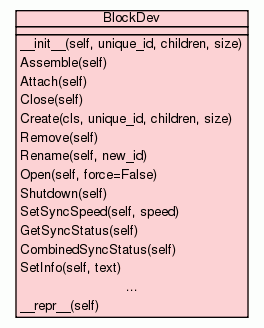Class BlockDev
source code

Block device abstract class.
A block device can be in the following states:
-
not existing on the system, and by `Create()` it goes into:
-
existing but not setup/not active, and by `Assemble()` goes into:
-
active read-write and by `Open()` it goes into
-
online (=used, or ready for use)
A device can also be online but read-only, however we are not using
the readonly state (LV has it, if needed in the future) and we are
usually looking at this like at a stack, so it's easier to conceptualise
the transition from not-existing to online and back like a linear
one.
The many different states of the device are due to the fact that we
need to cover many device types:
-
logical volumes are created, lvchange -a y $lv, and used
-
drbd devices are attached to a local disk/remote peer and made
primary
A block device is identified by three items:
-
the /dev path of the device (dynamic)
-
a unique ID of the device (static)
-
it's major/minor pair (dynamic)
Not all devices implement both the first two as distinct items. LVM
logical volumes have their unique ID (the pair volume group, logical
volume name) in a 1-to-1 relation to the dev path. For DRBD devices, the
/dev path is again dynamic and the unique id is the pair (host1, dev1),
(host2, dev2).
You can get to a device in two ways:
-
creating the (real) device, which returns you an attached instance
(lvcreate)
-
attaching of a python instance to an existing (real) device
The second point, the attachement to a device, is different depending
on whether the device is assembled or not. At init() time, we search for
a device with the same unique_id as us. If found, good. It also means
that the device is already assembled. If not, after assembly we'll have
our correct major/minor.
|
|
__init__(self,
unique_id,
children,
size)
x.__init__(...) initializes x; see x.__class__.__doc__ for signature |
source code
|
|
|
|
|
|
|
Attach(self)
Find a device which matches our config and attach to it. |
source code
|
|
|
|
Close(self)
Notifies that the device will no longer be used for I/O. |
source code
|
|
|
|
|
|
|
|
|
|
|
|
|
|
|
|
|
|
objects.BlockDevStatus
|
|
|
objects.BlockDevStatus
|
|
|
|
|
|
|
|
|
|
|
|
|
|
|
Inherited from object:
__delattr__,
__format__,
__getattribute__,
__hash__,
__new__,
__reduce__,
__reduce_ex__,
__setattr__,
__sizeof__,
__str__,
__subclasshook__
|
|
Inherited from object:
__class__
|
__init__(self,
unique_id,
children,
size)
(Constructor)
| source code
|
x.__init__(...) initializes x; see x.__class__.__doc__ for
signature
- Overrides:
object.__init__
- (inherited documentation)
|
|
Assemble the device from its components.
Implementations of this method by child classes must ensure that:
-
after the device has been assembled, it knows its major/minor
numbers; this allows other devices (usually parents) to probe
correctly for their children
-
calling this method on an existing, in-use device is safe
-
if the device is already configured (and in an OK state), this method
is idempotent
|
Create(cls,
unique_id,
children,
size)
Class Method
| source code
|
Create the device.
If the device cannot be created, it will return None instead. Error
messages go to the logging system.
Note that for some devices, the unique_id is used, and for other, the
children. The idea is that these two, taken together, are enough for both
creation and assembly (later).
|
|
Remove this device.
This makes sense only for some of the device types: LV and file
storage. Also note that if the device can't attach, the removal can't be
completed.
|
|
Rename this device.
This may or may not make sense for a given device type.
|
|
Make the device ready for use.
This makes the device ready for I/O. For now, just the DRBD devices
need this.
The force parameter signifies that if the device has any kind of
--force thing, it should be used, we know what we are doing.
|
|
Shut down the device, freeing its children.
This undoes the `Assemble()` work, except for the child assembling; as
such, the children on the device are still assembled after this call.
|
|
Adjust the sync speed of the mirror.
In case this is not a mirroring device, this is no-op.
|
|
Returns the sync status of the device.
If this device is a mirroring device, this function returns the status
of the mirror.
If sync_percent is None, it means the device is not syncing.
If estimated_time is None, it means we can't estimate the time needed,
otherwise it's the time left in seconds.
If is_degraded is True, it means the device is missing redundancy.
This is usually a sign that something went wrong in the device setup, if
sync_percent is None.
The ldisk parameter represents the degradation of the local data. This
is only valid for some devices, the rest will always return False (not
degraded).
- Returns: objects.BlockDevStatus
|
|
Calculate the mirror status recursively for our children.
The return value is the same as for `GetSyncStatus()` except the
minimum percent and maximum time are calculated across our children.
- Returns: objects.BlockDevStatus
|
|
Update metadata with info text.
Only supported for some device types.
|
|
Grow the block device.
- Parameters:
amount - the amount (in mebibytes) to grow with
|
|
Return the actual disk size.
Note:
the device needs to be active when this is called
|
|
repr(x)
- Overrides:
object.__repr__
- (inherited documentation)
|

